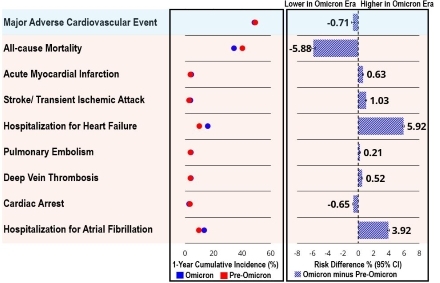Final ID: 067
Long-term Cardiovascular Outcomes After COVID-19 Hospitalization in the Omicron Era: Retrospective Cohort Study
Abstract Body: Introduction
Hospitalization for COVID-19 in the Pre-Omicron era was associated with an increased risk of major adverse cardiovascular events (MACE), but data from the Omicron era are sparse.
Hypothesis
We investigated the hypothesis that the risk of MACE among older adults hospitalized for COVID-19 during the Omicron era is lower than in the Pre-Omicron era, and is similar to that in a historical influenza cohort.
Methods
Retrospective cohort study using 100% of Medicare fee-for-service claims, including beneficiaries aged ≥ 65 years hospitalized for COVID-19 in the Omicron era (11/26/21–09/30/2022), for COVID-19 in the Pre-Omicron era (03/01/20 –11/25/21), or for influenza in the pre-COVID-19 era (03/01/16 – 09/30/18). Outcomes were measured at 1 year of follow-up after the index hospital admission date. The primary endpoint was the cumulative incidence proportion (risk) of MACE (composite of all-cause death, myocardial infarction, ischemic stroke/ transient ischemic attack, pulmonary embolism, deep vein thrombosis, heart failure hospitalization, and cardiac arrest). Secondary outcomes included individual components of MACE and hospitalization for atrial fibrillation. We used inverse probability weighting to allow comparisons to a common standard (Omicron cohort), the Kaplan-Meier method to estimate the cumulative incidence of outcomes including death, and the Aalen-Johansen method for outcomes that did not include death.
Results
The analysis included 363,719 patients in the Omicron cohort (mean age 79 years; 51% women; 18% dual enrollees), 724,657 in the Pre-Omicron cohort, and 149,572 in the influenza cohort. The risk of MACE at 1 year was lower in the Omicron than in the pre-Omicron cohort (48.6% vs. 49.3%, risk difference after standardization [RD], -0.7%; 95% CI -0.9% to -0.5%) but higher than in the influenza cohort (48.6% vs. 30.3%; RD, 18.3%; 18.1% – 18.6%). Compared with the pre-Omicron cohort, the Omicron cohort had a significantly lower risk of death at 1 year (34.2% vs. 40.1%, RD, -5.9%; -6.1% to -5.7%) but a higher risk of hospitalizations for myocardial infarction, stroke, heart failure, and atrial fibrillation (figure).
Conclusions
Among older adults, the risk of MACE within 1 year after COVID-19 hospitalization in the Omicron era has declined since the Pre-Omicron era, driven by all-cause death, but it remains elevated. Notably, during the Omicron period the risk of MACE is still higher than that observed in a historical influenza cohort.
Hospitalization for COVID-19 in the Pre-Omicron era was associated with an increased risk of major adverse cardiovascular events (MACE), but data from the Omicron era are sparse.
Hypothesis
We investigated the hypothesis that the risk of MACE among older adults hospitalized for COVID-19 during the Omicron era is lower than in the Pre-Omicron era, and is similar to that in a historical influenza cohort.
Methods
Retrospective cohort study using 100% of Medicare fee-for-service claims, including beneficiaries aged ≥ 65 years hospitalized for COVID-19 in the Omicron era (11/26/21–09/30/2022), for COVID-19 in the Pre-Omicron era (03/01/20 –11/25/21), or for influenza in the pre-COVID-19 era (03/01/16 – 09/30/18). Outcomes were measured at 1 year of follow-up after the index hospital admission date. The primary endpoint was the cumulative incidence proportion (risk) of MACE (composite of all-cause death, myocardial infarction, ischemic stroke/ transient ischemic attack, pulmonary embolism, deep vein thrombosis, heart failure hospitalization, and cardiac arrest). Secondary outcomes included individual components of MACE and hospitalization for atrial fibrillation. We used inverse probability weighting to allow comparisons to a common standard (Omicron cohort), the Kaplan-Meier method to estimate the cumulative incidence of outcomes including death, and the Aalen-Johansen method for outcomes that did not include death.
Results
The analysis included 363,719 patients in the Omicron cohort (mean age 79 years; 51% women; 18% dual enrollees), 724,657 in the Pre-Omicron cohort, and 149,572 in the influenza cohort. The risk of MACE at 1 year was lower in the Omicron than in the pre-Omicron cohort (48.6% vs. 49.3%, risk difference after standardization [RD], -0.7%; 95% CI -0.9% to -0.5%) but higher than in the influenza cohort (48.6% vs. 30.3%; RD, 18.3%; 18.1% – 18.6%). Compared with the pre-Omicron cohort, the Omicron cohort had a significantly lower risk of death at 1 year (34.2% vs. 40.1%, RD, -5.9%; -6.1% to -5.7%) but a higher risk of hospitalizations for myocardial infarction, stroke, heart failure, and atrial fibrillation (figure).
Conclusions
Among older adults, the risk of MACE within 1 year after COVID-19 hospitalization in the Omicron era has declined since the Pre-Omicron era, driven by all-cause death, but it remains elevated. Notably, during the Omicron period the risk of MACE is still higher than that observed in a historical influenza cohort.
More abstracts on this topic:
A Focus for Improvement - Factors for Lab Adherence in a Pediatric Preventive Cardiology Program
Holsinger Hunter, Porterfield Ronna, Taylor Makenna, Dresbach Bethany, Seipel Brittany, Igwe Chukwuemeka, Alvarado Chance, Tran Andrew
A Community-Based Intervention to Improve Cardiovascular Health Understanding in the Dallas-Fort Worth South Asian CommunityDeo Parminder, Rohatgi Anand, Sharma Parul, Sathyamoorthy Mohanakrishnan

